List of New Jersey state parks
The New Jersey Division of Parks and Forestry manages a public park system which consists of over 50 protected areas designated as state parks, state forests, recreation areas, and other properties within the state of New Jersey in the United States. The agency also owns and manages 38 historical sites and buildings throughout the state (some located within the boundaries of state parkland) and also owns five public marinas and four public golf courses. These properties are administered by the Division's State Park Service, founded in 1923. New Jersey's state park system includes properties as small as the 32-acre (0.13 km2) Barnegat Lighthouse State Park to the 115,000-acre (470 km2) Wharton State Forest, the state's largest. The state park system comprises 430,928 acres (1,743.90 km2)—roughly 7.7% of New Jersey's land area—and serves over 17.8 million annual visitors.

History of the New Jersey state park system
Forests and the Forest Park Reservation Commission
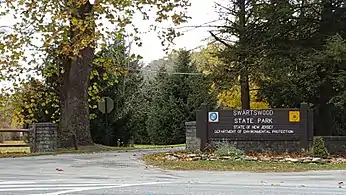
At the beginning of the twentieth century, New Jersey did not have much of a lumber or forestry industry. The value of its trees was insignificant and undermined by destruction by uncontrolled forest fires, and after decades of clear-cutting forests to fuel iron forges, furnaces, and other industrial operations.[1][2] In 1896, the state geologist recommended the acquisition of land for parks in order to protect water supplies and to provide natural recreation to the state's increasing urban populations.[3] After several years of reports and advocacy of geologists and naturalists (including, notably, U.S. forester Gifford Pinchot), New Jersey governor Edward C. Stokes established the Forest Park Reservation Commission in 1905 to protect forest land and create a system of park reserves within the state.[3][4][5] At the commission's meeting on September 12, 1905, the commissioners adopted the Salem Oak (of Salem, New Jersey) as a symbol of New Jersey's parks.[6] The commissioners acquired two tracts in southern New Jersey, near Mays Landing and along the Bass River, as the first state forest reserves.[7] The Mays Landing tract was sold in 1916 after opposition from local officials and landowners made acquisition and expansion on adjacent lands impossible. The Bass River tract became the core of Bass River State Forest.[8] In 1907, the commissioners would also acquire 5,000 acres (20 km2) on Kittatinny Mountain near Culver's Gap, supplemented by a gift from Governor Stokes, which would become the core of Stokes State Forest.[9] The reservations, which by 1912 comprised 13,720 acres (55.5 km2) became sites for studying forests, reforestation projects, and scientific forestry.[10] With the acquisition of a tract that included Swartswood Lake in Stillwater Township, the commission began developing parks for the purposes of recreation by providing boating, fishing, camping, and picnicking. In the Commission's 1915 Annual Report, they stated "It is intended to make Swartswood a public playground. Boat liveries and picnic shelters to be maintained under proper control will make it available to a large number of people".[11] The Forest Park Reservation Commission was consolidated with other agencies into the Department and Board of Conservation and Development on April 8, 1915.[12]
State Park Service

In 1923, the legislature authorized the creation of the State Park Service to administer the state parks and forests. New Jersey began to redirect its efforts from the development of these and other properties for recreational purposes instead of protecting or promoting the commercial potential of forested land. The state legislature established a commission to create a historic park along the Delaware River above Trenton, at the location where George Washington and Continental Army crossed the river on December 25, 1776 before the surprise attack on Hessian troops at the Battle of Trenton and the Battle of Princeton (January 3, 1777). The initial plans were defeated by a public referendum, but there was increased desire to complete these plans to establish a Washington Crossing Memorial Park in time for the 150th anniversary of American independence in 1926. The park was officially dedicated and opened to the public on June 4, 1927. In the wake of World War I, state forester Alfred Gaskill proposed a new public park along Kittatinny Mountain, "as the State’s memorial to its sons who had made the supreme sacrifice in the Great War". A few years later, Colonel Anthony R. Kuser donated his mountaintop estate at High Point (the state's highest elevation) to the state for a public park with an additional gift of $500,000 to erect a granite-clad obelisk to honor veterans. Construction of the monument began in 1928 and was completed in 1930.
According to the New Jersey Conservation Foundation, the New Jersey Division of Parks and Forestry administers and manages 430,928 acres (1,743.90 km2) in its state parks, forests, and other areas. These areas, during the state's 2006 fiscal year (from July 1, 2005 to June 30, 2006) recorded 17,843,541 visitors.[13]
Planning future parks
In 2006, the Division of Parks and Forestry began planning and preliminary work two new state parks: Great Falls State Park in Paterson, and Capital State Park in Trenton.[14][15] The state's only other urban park is Liberty State Park in Jersey City.[15] According to the master plan prepared by Philadelphia-based planning and urban design firm Wallace Roberts & Todd, Capital State Park would incorporate areas around the state's capitol complex in Trenton and the city's Delaware River and Assunpink Creek waterfronts to provide "a long-term strategy to revitalize Trenton by reestablishing connections to the downtown and reclaiming its riverfront."[16][17] Great Falls subsequently became Paterson Great Falls National Historical Park.
In 2009, the state also purchased 1,174 acres (4.75 km2) in Jefferson Township the former site of the Mount Paul monastery and seminary belonging to Paulist Fathers (from 1924–2009). The tract, which will be developed into a state park, is located in the state's Highlands region on the eastern side of Sparta Mountain and featuring mountain streams that flow into the Russia Brook (a tributary of the Rockaway River).[18]
Recreation and facilities

The State Park Service asks its visitors to embrace the "Carry In, Carry Out" philosophy in order to "keep the parks clean and beautiful by carrying out the trash you carry in".[19]
Fishing and hunting are permitted in several of the state parks and forest.[19]
Golf courses
The State Park System also includes four golf courses that are open to the public. Each of the four courses include associated restaurant and banquet facilities and is operated under contract between a private management company and the New Jersey Division of Parks and Forestry.[20] Centerton Golf Course, located in Pittsgrove Township in Salem County is located within Parvin State Park.[21] Cream Ridge Golf Course is located in Cream Ridge in Monmouth County and was acquired by the state in 2006.[22] Spring Meadow Golf Course in Farmingdale in Monmouth County was privately developed and operated beginning in the 1920s and acquired by the state five decades later.[23]
- White Oaks Golf Course - Gloucester County 2951 Dutch Mill Road Newfield, NJ 08344
Several of these properties were acquired as part of open space preservation initiatives managed by the New Jersey Department of Environmental Protection's Green Acres Program.[21][23]
State Parks
| Park Name | Image | Location | Year Established | Size | Remarks | Links |
|---|---|---|---|---|---|---|
| Allaire State Park | 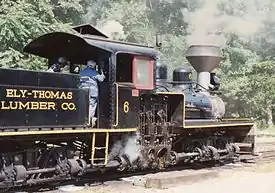 | Howell and Wall townships in Monmouth County 40°9′43.60″N 74°7′53.62″W | 1940 | 3,205 acres (12.97 km2) | Features restored nineteenth-century ironworks, Allaire Village; ecosystem and geography of New Jersey's coastal plains region and Manasquan River floodplain—habitat for over 200 species of wildflowers, trees and plants, and birds; includes high-iron and acidic podzolic soils and bog iron deposits. Hosts the Pine Creek Railroad, an excursion rail line operated by the New Jersey Museum of Transportation. | [24][25] |
| Allamuchy Mountain State Park |  | Green and Byram townships in Sussex County; Allamuchy Township in Warren County Mount Olive Township in Morris County 40°55′16.48″N 74°46′56.00″W | 1966 | 9,092 acres (36.79 km2) | Located along Allamuchy Mountain and Musconetcong River, features 2,440-acre (9.9 km2) Allamuchy Natural Area of mature mixed oak-hardwood forests, natural fields; 14 miles (23 km) of marked and 20 miles (32 km) of unmarked trails including Sussex Branch Trail and Highlands Trail. | [26] |
| Barnegat Lighthouse State Park | .JPG.webp) | At the northern tip of Long Beach Island in Ocean County 39°45′46.91″N 74°6′28.74″W | 1951 | 32 acres (0.13 km2) | The site of Barnegat Lighthouse (1859); offers marine birdwatching and saltwater fishing, located along on New Jersey Coastal Heritage Trail Route. | [27] |
| Cape May Point State Park |  | Lower Township in Cape May County 38°55′59.35″N 74°57′39.33″W | 1972 | 244 acres (0.99 km2) | The site of Cape May Lighthouse (1859); premier location in North America for observing fall bird migration to the south. | [28][29] |
| Capital State Park | Trenton in Mercer County | 2006 | - | Park currently being developed, includes buildings and areas of Trenton's capitol complex, waterfront areas along Delaware River and Assunpink Creek; celebrate Trenton's Native American, Colonial, Revolutionary War, ethnic, and industrial heritage | [16] | |
| Cheesequake State Park |  | Old Bridge Township in Middlesex County 40°26′6″N 74°16′13″W | 1940 | 1,610 acres (6.5 km2) | Transitional zone between two different ecosystems featuring open fields, saltwater and freshwater marshes, Pine Barrens white cedar swamp, and northeastern hardwood forest. | [30] |
| Corson's Inlet State Park |  | Corson's Inlet between Ocean City and Strathmere in Cape May County 39°13′1.95″N 74°38′46.52″W | 1963 | 341 acres (1.38 km2) | One of the last undeveloped tracts along the state's oceanfront; features primary and secondary sand dune systems, shoreline overwash, marine estuaries; migratory and residential wildlife species; hiking, fishing, crabbing, boating and sunbathing. | [31] |
| Delaware and Raritan Canal State Park |  | Over 60 miles (97 km) through Central New Jersey in Middlesex, Somerset, Mercer, and Hunterdon counties. 40°22′7.27″N 74°36′58.14″W | 1974 | 6,595 acres (26.69 km2) | Delaware and Raritan Canal mileage including the 36-mile (58 km) main canal between New Brunswick and Trenton and 22-mile (35 km) feeder canal between Trenton and Frenchtown; many historic structures including buildings, locks, spillways, and towpath; described as "the longest (and narrowest) recreation area in the state. A greenway that snakes through one of the most heavily populated regions in the world." | [32][33] |
| Double Trouble State Park |  | Lacey and Berkeley townships in Ocean County 39°53′52.36″N 74°13′16.65″W | 1964 | 8,495 acres (34.38 km2) | Provides "a window into the Pine Barrens history" and region's ecosystem; preserved historic village associated with New Jersey cranberry agriculture and Atlantic White Cedar logging and milling industries. | [34] |
| Farny State Park | 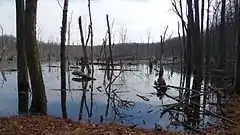 | Rockaway Township in Morris County 40°57′44.82″N 74°27′28.81″W | 1943 | 4,866 acres (19.69 km2) | Adjacent to Splitrock Reservoir; features mature mixed oak hardwood forest, swamps, and streams characteristic of the Highlands physiographic province; provides habitat for the endangered red-shouldered hawk and threatened barred owl. | [35] |
| Fort Mott State Park |  | Pennsville Township in Salem County 39°36′11″N 75°33′9″W | 1951 | 124 acres (0.50 km2) | Coastal defense battery built 1872–1902 to protect the Delaware River and Philadelphia after the American Civil War. Troops were stationed at site from 1897 to 1922. | [36][37][38] |
| Hacklebarney State Park |  | Located between Long Valley and Chester in Morris County 40°45′5.04″N 74°44′9.63″W | 1924 | 1,186 acres (4.80 km2) | The glacial valley and gorge of the Black River; features the rock strewn landscape of the glacial moraine from the Wisconsinan glaciation; features three endangered species: American ginseng, leatherwood and Virginia pennywort | [39] |
| High Point State Park |  | Montague Township, Sussex County 41°18′23.04″N 74°40′14.78″W | 1923 | 16,091 acres (65.12 km2) | Donated by Colonel Anthony R. Kuser and wife Susie Dryden Kuser; landscaping designed by the Olmsted Brothers of Boston, sons of Frederick Law Olmsted, designer of New York City's Central Park. Features the highest elevation in New Jersey, High Point, a 1,803-foot (550 m) prominence of Kittatinny Mountain marked by a 220-foot (67 m) granite obelisk erected as veterans memorial. | [40] |
| Hopatcong State Park | 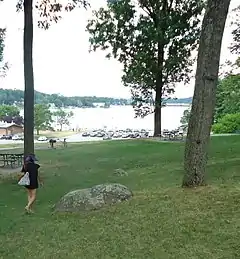 | Landing, Roxbury Township in Morris County; Hopatcong Borough in Sussex County 40°54′52″N 74°39′55″W | 1922 | 163 acres (0.66 km2) | Two separate parcels of land, one on the southwestern shore of state's largest freshwater lake, Lake Hopatcong, another on Lake Musconetcong; the park features remnants of the Morris Canal and Lake Hopatcong Historical Museum. | [41] |
| Island Beach State Park |  | Former borough of Island Beach and Berkeley Township in Ocean County 39°54′18.98″N 74°4′53.15″W | 1953 | 3,003 acres (12.15 km2) | Island Beach is a narrow 10-mile (16 km) barrier island between Atlantic Ocean and Barnegat Bay featuring untouched primary dunes, thicket, freshwater wetlands, maritime forest and tidal marshes; also New Jersey's largest osprey colony, peregrine falcons, wading birds, shorebirds, waterfowl, and migrating songbirds. | [42] |
| Kittatinny Valley State Park |  | Andover Borough and Andover Township, Sussex County 41°0′58.86″N 74°44′38.10″W | 1994 | 5,656 acres (22.89 km2) | Features glacial lakes and limestone outcroppings at the headwaters of the Pequest River; part of the Sussex Branch Trail passes through park; site of the Aeroflex–Andover Airport, a New Jersey Forest Fire Service airbase for aerial wildfire suppression. | [43] |
| Liberty State Park |  | Jersey City in Hudson County 40°41′59.57″N 74°3′41.19″W | 1976 | 1,212 acres (4.90 km2) | Created to commemorate country's bicentennial celebration, features Central Railroad of New Jersey Terminal (CRRNJ); sweeping view of the Hudson River and Manhattan skyline; Liberty Science Center; "Empty Sky" Memorial for the September 11 terrorist attacks; ferry service to Ellis Island and the Statue of Liberty. | [44] |
| Long Pond Ironworks State Park |  | Hewitt, West Milford Township in Passaic County 41°8′27.55″N 74°18′33.22″W | 1974 | 6,911 acres (27.97 km2) | Features Monksville Reservoir and ruins of Long Pond Ironworks, an eighteenth- and nineteenth-century ironworking community (1766–1882) along the Wanaque River. | [45] |
| Monmouth Battlefield State Park |  | Manalapan and Freehold, in Monmouth County 40°15′22.13″N 74°19′14.59″W | 1961 | 1,818 acres (7.36 km2) | Site of the June 28, 1778 Battle of Monmouth during the American Revolution. George Washington and Continental Army attacked the rear of a British Army column commanded by Lieutenant General Sir Henry Clinton; features interpretative center, annual reenactment battle held in June, the Craig House (1746), the Rhea-Applegate house (1745), and a pick-your-own fruit orchard. | [46] |
| Parvin State Park |  | Pittsgrove Township in Salem County 39°30′39.07″N 75°7′57.51″W | 1931 | 2,092 acres (8.47 km2) | Features Pine Barrens swamp hardwood and pine forest ecosystem along Muddy Run (Maurice River tributary). Features over 200 flowering plant species including blossoming dogwood, laurel, holly, magnolia, wild azalea. Historically, the home of a CCC camp (1933–1941), summer displacement camp for Japanese-American children during World War II; prisoner-of-war camp for German soldiers, and housing for Kalmyk refugees who escaped Eastern Europe and the USSR in 1952. | [47] |
| Pigeon Swamp State Park | 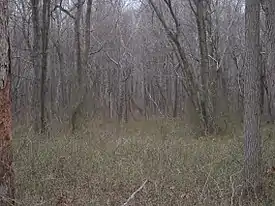 | South Brunswick Township in Middlesex County 40°23′12.8″N 74°28′25.7″W | 1965 | 1,078 acres (4.36 km2) | Located in the watershed of Lawrence Brook, an undeveloped park featuring open ponds and hardwood forests that were a major nesting site for the now-extinct passenger pigeon. | - |
| Princeton Battlefield State Park | .JPG.webp) | Princeton Borough in Mercer County 40°19′51.09″N 74°40′36.68″W | 1777 | 681 acres (2.76 km2) | Site of the Battle of Princeton fought between British and American on January 3, 1777 — a victory that proved decisive in restoring American morale during American Revolution. Includes the Clarke House where General Hugh Mercer died from his wounds nine days later despite the efforts of Dr. Benjamin Rush. | [48] |
| Rancocas State Park | 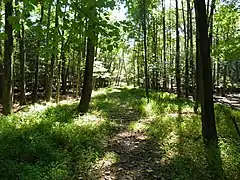 | Westampton Township in Burlington County 40°0′27.13″N 74°49′59.59″W | 1965 | 1,252 acres (5.07 km2) | Located along the North Branch of the Rancocas Creek and an extensive freshwater tidal marsh. | [49] |
| Ringwood State Park | 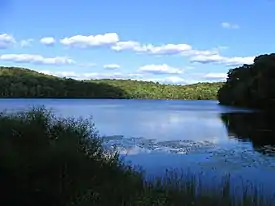 | Ringwood in Passaic County 41°8′10.52″N 74°15′21.99″W | 1937 | 4,444 acres (17.98 km2) | Located on Ramapo Mountain, features historic Ringwood Manor, New Jersey Botanical Garden at Skylands Manor, and Shepherd Lake Recreation Area. | [50] |
| Stephens State Park | 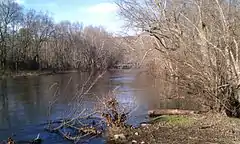 | near Hackettstown in Warren County; Mount Olive Township in Morris County 40°52′9.06″N 74°48′36.00″W | 1937 | 805 acres (3.26 km2) | Located along Musconetcong River, features remnants of one of 23 locks and section of towpath of the Morris Canal. Highlands Trail runs through the park. | [51] |
| Swartswood State Park | 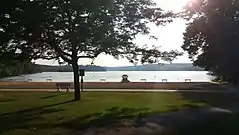 | Stillwater Township, Sussex County 41°4′25.07″N 74°49′7.62″W | 1914 | 3,460 acres (14.0 km2) | New Jersey's first state park. The focus of the park was a place for recreation at the state's third-largest freshwater lake, Swartswood Lake (a glacial lake). | [52] |
| Tall Pines State Preserve |  | Deptford Township and Mantua Township in Gloucester County 39°46′41″N 75°8′31″W | 2015 | 110 acres (0.45 km2) | Former golf course with over 4 miles of asphalt and grass walking trails through unmaintained natural areas. Mantua Creek runs through its center. | [53] |
| Voorhees State Park | 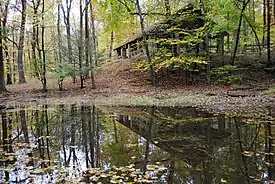 | Glen Gardner Borough, Hunterdon County 40°41′45.53″N 74°53′13.68″W | 1927 | 1,336 acres (5.41 km2) | Former New Jersey governor Foster M. Voorhees created the park with donation of his 325-acre (1.32 km2) farm; scenic views of Round Valley Reservoir and Spruce Run Reservoir; an observatory and astronomy education center, operated by the New Jersey Astronomical Association, offers the largest working telescope accessible to the public in the state—a 26-inch Cassegrain reflector. | [54] |
| Washington Crossing State Park |  | Washington Crossing and Titusville sections of Hopewell Township in Mercer County 40°18′40″N 74°51′49″W | 1912 | 3,575 acres (14.47 km2) | Commemorates site where General George Washington and the Continental Army crossed the Delaware River on the night of December 25–26, 1776, before the Battle of Trenton during the American Revolution. | [55] |
| Washington Rock State Park |  | Green Brook Township, Somerset County 40°36′47.65″N 74°28′23.70″W | 1932 | 52 acres (0.21 km2) | Site of a lookout used by George Washington in 1777 monitor British troop movements around New York City and northern New Jersey when the Continental Army was stationed at the Middlebrook encampment. | [56] |
| Wawayanda State Park |  | Vernon Township in Sussex County; West Milford in Passaic County 41°11′53.203″N 74°23′51.892″W | 1960 | 35,524 acres (143.76 km2) | Wawayanda offers 60 miles (97 km) of trails including a 20-mile (32 km) segment of the Appalachian Trail. Features 1,325-acre (5.36 km2) Bearfort Mountain Natural Area, 399-acre (1.61 km2) Wawayanda Hemlock Ravine Natural Area (399 acres (1.61 km2)), and 2,167-acre (8.77 km2) Wawayanda Swamp Natural Area | [57] |
State forests
| State park | Image | Location | Created | Size | Features and activities | Links |
|---|---|---|---|---|---|---|
| Abram S. Hewitt State Forest |  | near Hewitt, West Milford Township in Passaic County 41°11′8.5363″N 74°19′52.9500″W | 1951 | 2,001 acres (8.10 km2) | Accessible only by foot, this park is located on Bearfort Mountain, the eastern terminus of the Wawayanda Plateau, between Greenwood Lake and Upper Greenwood Lake and features a portion of the Appalachian Trail | [58] |
| Bass River State Forest | 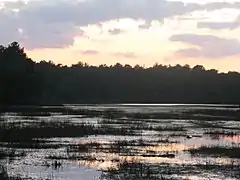 | Burlington County 39°37′13.91″N 74°25′28.74″W | 1906 | 29,147 acres (117.95 km2) | Bass River is New Jersey's first state forest. Features the 67-acre (0.27 km2) man-made Lake Absegami, the remains of the Civilian Conservation Corps Camp S-55 (1933–1942), a 3,830 acres (15.5 km2) portion of Pine Barrens pygmy forest in the West Pine Plains Natural Area, and the pine/oak woods and a small Atlantic white cedar bog of the Absegami Natural Area | [59] |
| Belleplain State Forest | 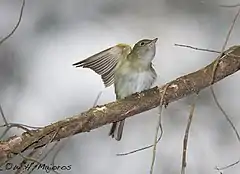 | near Woodbine in Cumberland and Cape May counties 39°14′56.62″N 74°50′28.29″W | 1928 | 21,324 acres (86.30 km2) | Features young pine, oak and Atlantic white cedar, and the remains of three CCC camps, and Lake Nummy, formerly the Meisle Cranberry Bog | [60] |
| Brendan T. Byrne State Forest |  | New Lisbon, Woodland Township in Ocean County 39°53′27.66″N 74°34′46.63″W | 1908 | 37,242 acres (150.71 km2) | Features the site of Lebanon Glass Works (1851–1867); Whitesbog Village, an active nineteenth- and twentieth-century cranberry and blueberry producing community where the high bush blueberry was developed. | [61] |
| Jenny Jump State Forest |  | Hope in Warren County 40°55′19.3″N 74°55′32.1″W | 1931 | 4,466 acres (18.07 km2) | The park features the 1,112-foot (339 m) high, 6-mile (10 km) long Jenny Jump Mountain ridge, large glacial boulders and outcroppings from the Wisconsin glaciation, and because the area enjoys the darkest skies in New Jersey, the park is home to the United Astronomy Clubs of New Jersey's Greenwood Observatory, open for public stargazing. | [62] |
| Norvin Green State Forest |  | West Milford Township and Bloomingdale Borough in Passaic County 41°4′8.00″N 74°19′32.37″W | 1946 | 5,416 acres (21.92 km2) | Located near Wanaque Reservoir and part of the Wyanokie Wilderness Area, this state forest features Wyanokie High Point and views of the Manhattan skyline is part of the Northeastern coastal forests ecoregion and accessible only by foot. | [63] |
| Penn State Forest |  | Jenkin's Neck in Burlington County 39°44′04.90″N 74°29′28.82″W | 1910 | 3,366 acres (13.62 km2) | Features Oswego Lake and River and a former Civilian Conservation Corps camp, as well as part of New Jersey's pygmy forest. | [64] |
| Ramapo Mountain State Forest |  | Passaic and Bergen counties 41°1′58.10″N 74°15′6.57″W | - | 4,269 acres (17.28 km2) | Former estate of Clifford MacEvoy on Ramapo Mountain, includes the 120-acre (0.49 km2) Ramapo Lake Natural Area | - |
| Stokes State Forest |  | Sandyston, Montague, and Frankford townships in Sussex County 41°11′4.03″N 74°47′50.33″W | 1917 | 16,025 acres (64.85 km2) | Created with a donation of land by New Jersey Governor Edward C. Stokes, this state forest on Kittatinny Mountain includes the Tillman Ravine Natural Area, and New Jersey School of Conservation (operated by Montclair State University) | - |
| Wharton State Forest |  | Large tract through Burlington, Camden, and Atlantic counties 39°38′38.0″N 74°38′48.4″W | 1954 | 115,000 acres (470 km2) | New Jersey's largest state forest, features the Atlantic coastal pine barrens ecoregion as well as the New Jersey Pinelands National Reserve, and the watershed of the Mullica River, including historic Batsto Village, a former bog iron and glass manufacturing site from 1766 to 1867, and extensive hiking trails. | - |
| Worthington State Forest |  | Knowlton and Hardwick townships in Warren County 41°0′0.00″N 75°4′12.00″W | 1954 | 6,421 acres (25.98 km2) | Part of the former estate of Charles Campbell Worthington, features Mount Tammany (elevation 1,527 feet (465 m)), the New Jersey side of the Delaware Water Gap and southern areas of Kittatinny Mountain, including the 1,085-acre (4.39 km2) Dunnfield Creek Natural Area (a Wild Trout stream) and Sunfish Pond, a glacial lake | - |
Recreation areas
| State park | Image | Location | Created | Size | Features and activities | Notes |
|---|---|---|---|---|---|---|
| Atsion Recreation Area |  | Shamong Township in Burlington County 39°44′28″N 74°43′59″W | - | - | Located in Wharton State Forest | - |
| Bull's Island Recreation Area | 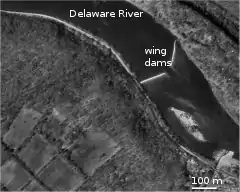 | Delaware and Raritan Canal State Park Delaware Township in Hunterdon County 40°24′37.62″N 75°2′5.27″W | - | 80 acres (0.32 km2) | - | [65] |
| Round Valley Recreation Area |  | Lebanon and Clinton townships in Hunterdon County 40°36′50.0″N 74°49′21.7″W | 1968 | 3,684 acres (14.91 km2) | Trails for hiking, horseback riding, and mountain biking; camping, fishing, hunting (waterfowl only), picnicking, boating/canoeing (gas motors limited 10 hp), swimming, scuba and skin diving, cross-country skiing, ice fishing, sledding | [66] |
| Spruce Run Recreation Area | 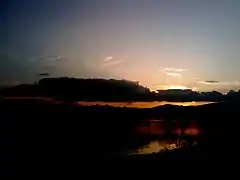 | Union and Clinton townships in Hunterdon County 40°39′46″N 74°56′20″W | 1974 | 1,290 acres (5.2 km2) | - | - |
| Warren Grove Recreation Area | - | Warren Grove in Ocean and Burlington counties 39°45′12.29″N 74°23′13.9″W | 1972 | 617 acres (2.50 km2) | Administered by the Bass River State Forest, this site was acquired from the National Park Service in 1972. This site is part of what is known as the "Pygmy Forest", featuring the groves of Pitch Pine that is part of the Dwarf Pine Plains Habitat in the New Jersey Pine Barrens. Features the endangered broom crowberry (Corema conradii) and other rare plant species. | [67] |
State marinas
| Marina | Image | Location | Berths | Maximum vessel length | Draft | Description | Links |
|---|---|---|---|---|---|---|---|
| Senator Frank S. Farley State Marina | - | Atlantic City, Atlantic County 39°22′40.30″N 74°25′47.58″W | 640 | 300 feet (91 m) | 12 feet (3.7 m) | Located on Clam Creek and Huron Avenue across the street from the Golden Nugget (formerly Trump Marina Hotel and Casino) in Atlantic City, access to the Atlantic Ocean through Absecon Inlet or the Intracoastal Waterway | [68] |
| Forked River State Marina | - | Forked River in Lacey Township, Ocean County 39°50′05.59″N 74°11′42.07″W | 125 | 50 feet (15 m) | 6 feet (1.8 m) | Access to Atlantic Ocean via Barnegat Inlet, near "BB" Buoy, Barnegat Bay and the Intracoastal Waterway | [68] |
| Fortescue State Marina | - | Fortescue, Downe Township, Cumberland County 39°14′35.5″N 75°10′20.6″W | 125 | 50 feet (15 m) | 9 feet (2.7 m) | Access to Delaware Bay and Atlantic Ocean. | [68] |
| Leonardo State Marina | - | Leonardo in Middletown Township, Monmouth County 40°25′20.74″N 74°03′40.26″W | 176 | 50 feet (15 m) | 6 feet (1.8 m) | Located next to Sandy Hook, access to the Atlantic Ocean and New York Bay | [68] |
| Liberty Landing Marina | - | Liberty State Park in Jersey City, Hudson County 40°42′35.46″N 74°03′05.40″W | 200 | 50 feet (15 m) | 18 feet (5.5 m) | Located in Liberty State Park across from Manhattan, with access to Liberty Science Center, and by ferry to the Statue of Liberty, Ellis Island and New York City. | [68] |
State-owned historic sites
These are state-owned historical sites in New Jersey.[69] These state-owned historical sites are open to the public year-round on Wednesdays through Sundays (10:00 a.m. to 12:00 p.m., 1:00 p.m. to 4 p.m.)
| Historical site | Image | Location | Acquired | Historical significance | Links |
|---|---|---|---|---|---|
| Absecon Lighthouse | 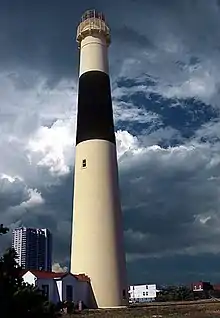 | Atlantic City, Atlantic County 39°21′58″N 74°24′50″W | - | - | - |
| Allaire Village | 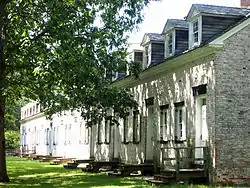 | 40°9′31.0″N 74°7′44.0″W | - | - | - |
| Barnegat Lighthouse | 39°45′50″N 74°6′22″W | - | - | - | |
| Batsto Village |  | 39°38′30.1″N 74°38′52.1″W | - | - | - |
| Blackwells Mills Canal House |  | 40°28′31.4″N 74°34′19.2″W | - | Delaware and Raritan Canal State Park | - |
| Boxwood Hall | 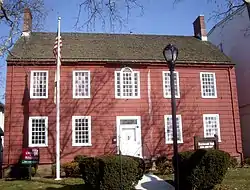 | 40°39′49.0″N 74°12′37.1″W | - | - | - |
| Cape May Light | 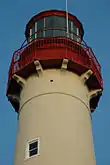 | 38°55′58.8″N 74°57′37.4″W | - | - | - |
| Central Railroad of New Jersey Terminal |  | 40°42′29.9″N 74°2′39.1″W | - | - | - |
| Clarke House |  | - | - | - | - |
| Craig House |  | - | - | - | - |
| Double Trouble Village | - | - | - | - | - |
| Edison Memorial Tower and Museum | - | - | - | - | - |
| Fort Mott | - | - | - | - | - |
| Grover Cleveland Birthplace | 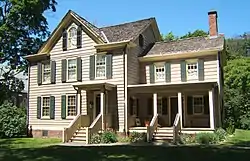 | - | - | - | - |
| Hancock House |  | - | - | - | - |
| The Hermitage |  | - | - | - | - |
| High Point Monument | 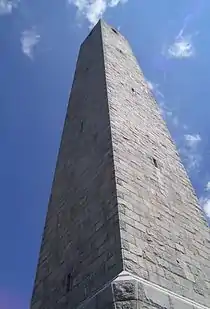 | - | - | - | - |
| Indian King Tavern |  | - | - | - | - |
| Johnson Ferry House |  | Washington Crossing, Mercer County 40°17′57″N 74°52′5″W | - | Washington Crossing State Park | - |
| Long Pond Ironworks Historic District |  | - | - | - | - |
| Monmouth Battlefield | 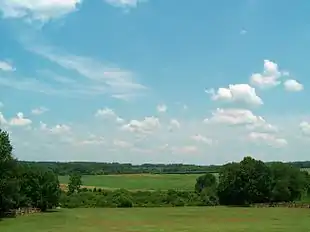 | - | - | - | - |
| Mule Tenders Barracks | - | - | - | Delaware and Raritan Canal State Park | - |
| Navesink Twin Lights |  | Highlands, Monmouth County 40°23′46.4″N 73°59′8.8″W | 1962 | Located 246 feet (75 m) above sea level on the headlands of the Navesink Highlands; built in 1862 to replace an earlier lighthouse (1828); first American lighthouse to test a Fresnel lens; site of a demonstration by Marconi of the wireless telegraph in 1899. | - |
| Old Dutch Parsonage | 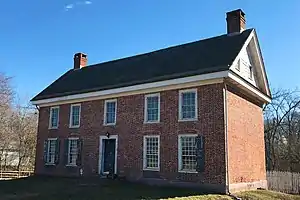 | Somerville, Somerset County | 1947 | Built in 1751 (relocated to present site in 1913), the home of two Dutch Reformed clergymen: John Frelinghuysen and Jacob Rutsen Hardenbergh who served local congregations in the Raritan River valley; and Frederick Frelinghuysen, a Revolutionary War officer, later a general, father to Theodore Frelinghuysen. Frelinghuysen and Hardenbergh were influential in establishing Queen's College (now Rutgers University) in 1766—of which Hardenbergh was its first president. | - |
| Port Mercer Canal House | 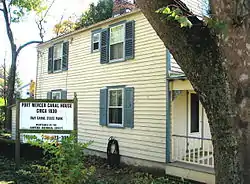 | - | - | Delaware and Raritan Canal State Park | - |
| Prallsville Mills |  | - | - | Delaware and Raritan Canal State Park | - |
| Princeton Battlefield |  | - | - | - | - |
| Ringwood Manor |  | - | - | - | - |
| Rockingham |  | - | - | - | - |
| Skylands Manor & State Botanical Garden | 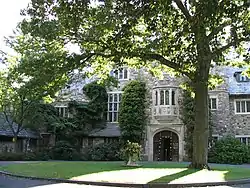 | - | - | - | - |
| Somers Mansion |  | - | - | - | - |
| Steuben House | 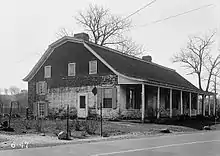 | - | - | - | - |
| Trenton Battle Monument |  | - | - | - | - |
| Wallace House | 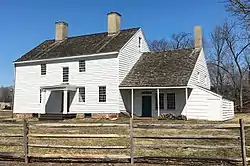 | Somerville, Somerset County 40°34′8″N 74°37′19″W | 1947 | An eight-room Georgian mansion built on the "Hope Farm" estate of John Wallace in 1778–79. During the second Middlebrook encampment, George Washington used the home as his headquarters in the first half of 1779 and used it to host foreign dignitaries and plan military strategy during the American Revolution. | - |
| Walt Whitman House | 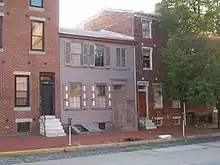 | Camden, Camden County 39°56′33″N 75°07′26″W | 1947 | The small six-room home was purchased by the American poet Walt Whitman in 1884 and he resided there in his declining years until his death in 1892. Today it houses a museum with many of Whitman's belongings and pieces of furniture. | [70] |
| Washington Crossing |  | Hopewell Township, Mercer County 40°18′40″N 74°51′49″W | - | Washington Crossing State Park | - |
| Waterloo Village | 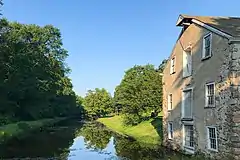 | Byram Township Sussex County 40°54′56″N 74°45′22″W | - | Restored eighteenth- and nineteenth-century village associated with the iron industry and Morris Canal. | - |
| Whitesbog Village | 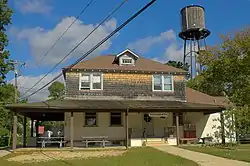 | - | - | - | - |
See also
- List of New Jersey wildlife management areas
- List of Registered Historic Places in New Jersey
- Palisades Interstate Park - a protected area overseen by both New York and New Jersey along the Hudson River.
References
- Gifford Pinchot, "A Study of Forest Fires and Wood Production in Southern New Jersey" in New Jersey Geological Survey, The Annual Report of the State Geologist for 1898 (Trenton: MacCrellish & Quigley, 1897). Appendix.
- "Damage By Forest Fires, New Jersey Legislature to be Asked for Protection", The New York Times, January 5, 1896, page 16; "Forest Fires In New Jersey. The annual Loss Over $1,000,000—Need of Legislation to Save Timber Lands", The New York Times, April 16, 1893, page 10; "Caring for Jersey Forests. State Spending Money to Stop Fires and Promote an Industry", The New York Times, May 15, 1910, page 20.
- John Conover Smock, "Natural Parks and Forest Reservations: Administrative Report", in New Jersey Geological Survey, The Annual Report of the State Geologist for the Year 1896 (Trenton: MacCrellish & Quigley, 1897), xxii-xxiii.
- P.L. 1905, ch. 47
- P.L. 1906, ch. 123 printed in Forest Park Reservation Commission, State of New Jersey, Reports of the Forest Park Reservation Commission of New Jersey: Second Annual Report for the Year Ending October 31st 1906 (Trenton: MacCrellish & Quigley, 1907).
- Minutes of the Board of Forest Park Reservation Commissioners, New Jersey State Archives, Meeting of September 12, 1905.
- "Saving Jersey’s Forests. State Buys Two Tracts of Land for Timber Experiments", The New York Times, October 6, 1905, page 9.
- Kevin Wright, A Century of Forest Stewardship in New Jersey 1905-2005 (2005). Retrieved September 30, 2015.
- Sussex County Deed Book H-10, p. 467; 18 May 1907, Lands in Townships of Sandyston and Frankford, parts of Lots 3, 4, 39, 43, 44, 45, 46, 47, 48, 49, 52, and 53 of the Sussex Allotments from Noah H. Hopkins and Susan Hopkins, his wife, of Branchville, New Jersey, to the State of New Jersey for $5,000.
- Annual Report For the Year Ending June 30, 1920, Department of Conservation and Development, (Trenton: 1920).
- Reports of the Forest Park Reservation Commission of New Jersey: Tenth Annual Report for the Year Ending October 31st 1914 (Paterson: The News Printing Company, 1915).
- State of New Jersey, P.L. 1915, ch. 241.
- Elliott Ruga, "Table 9: Acreage by Land Use of Lands Under the Jurisdiction of NJDEP Division of Parks and Forestry" and "Table 10: State Park and Forest Attendance, July 1, 2005 – June 30, 2006", The Accomplishments of State Preservation Programs: A Compilation of Reports, Plans and other Studies Detailing Land Preservation, Farmland Preservation and Historic Preservation Accomplishments with State Funding in New Jersey (New Jersey Conservation Foundation, 2009), 20–21.
- New Jersey Division of Parks and Forestry, Parks: Great Falls State Park. Retrieved October 19, 2015.
- New Jersey Division of Parks and Forestry, Parks: Capital State Park. Retrieved October 15, 2015.
- Wallace Roberts & Todd, Projects: New Jersey Capital Park Master Plan. Retrieved October 15, 2015.
- Wallace Robert & Todd, Chapter 1: Vision: Recasting Trenton, New Jersey Capital Park Master Plan (May 2013 version). Retrieved October 15, 2015.
- Rosa Kasper, "Sale means Mt. Paul will become state park", AIM Jefferson / northjersey.com, October 9, 2009. Retrieved October 15, 2015.
- New Jersey Division of Parks and Forestry, State Park Service. Retrieved September 29, 2015.
- New Jersey Department of Environmental Protection, Division of Parks and Forestry, Golf Courses. Retrieved October 1, 2015.
- Centerton Golf Course, "About Us". Retrieved October 1, 2015.
- Cream Ridge Golf Course, "About Us". Retrieved October 1, 2015.
- Spring Meadow Golf Course, "About Us". Retrieved October 1, 2015.
- New Jersey Division of Parks and Forestry, Parks: Allaire State Park. Retrieved September 30, 2015.
- New Jersey Museum of Transportation (official website). Retrieved September 30, 2015.
- New Jersey Division of Parks and Forestry, Parks: Allamuchy Mountain State Park. Retrieved September 30, 2015.
- New Jersey Division of Parks and Forestry, Parks: Barnegat Lighthouse State Park. Retrieved September 30, 2015.
- New Jersey Division of Parks and Forestry, Parks: Cape May Point State Park. Retrieved September 30, 2015.
- Clay Sutton; Patricia Sutton (2006). Birds and Birding at Cape May. Stackpole Books. p. 470. ISBN 978-0-8117-3134-8.
- New Jersey Division of Parks and Forestry, Parks: Cheesequake State Park. Retrieved September 30, 2015.
- New Jersey Division of Parks and Forestry, Parks: Corson's Inlet State Park. Retrieved September 30, 2015.
- New Jersey Division of Parks and Forestry, Delaware and Raritan Canal State Park. Retrieved September 30, 2015.
- Anthony Venutolo, "You can soak up the history or just take in the scenery at New Jersey's gem of a park", The Star-Ledger, September 3, 2009. Retrieved September 30, 2015.
- New Jersey Division of Parks and Forestry, Parks: Double Trouble State Park. Retrieved September 29, 2015.
- New Jersey Division of Parks and Forestry, Parks: Farny State Park. Retrieved September 30, 2015.
- Chidley, George A. (December 6, 1977). "National Register of Historic Places Inventory/Nomination: Fort Mott and Finns Point National Cemetery District". National Park Service.
- New Jersey Division of Parks and Forestry, Parks: Fort Mott State Park. Retrieved September 30, 2015.
- Mark A. Berhow (editor), American Seacoast Defenses, A Reference Guide, Second Edition (CDSG Press, 2004), 198, 230. ISBN 0-9748167-0-1; Emanuel Raymond Lewis, "Fort Mott", Seacoast Fortifications of the United States (Annapolis: Leeward Publications, 1979). ISBN 978-0-929521-11-4.
- New Jersey Division of Parks and Forestry, Parks: Hacklebarney State Park. Retrieved September 30, 2015.
- New Jersey Division of Parks and Forestry, Parks: High Point State Park. Retrieved September 29, 2015.
- New Jersey Division of Parks and Forestry, Parks: Hopatcong State Park. Retrieved September 30, 2015.
- New Jersey Division of Parks and Forestry, Parks: Island BEach State Park. Retrieved September 30, 2015.
- New Jersey Division of Parks and Forestry, Parks: Kittatinny Valley State Park. Retrieved September 30, 2015.
- New Jersey Division of Parks and Forestry, Parks: Liberty State Park. Retrieved September 30, 2015.
- New Jersey Division of Parks and Forestry, Parks: Long Pond Ironworks State Park. Retrieved September 30, 2015.
- New Jersey Division of Parks and Forestry, Monmouth Battlefield State Park. Retrieved September 30, 2015.
- New Jersey Division of Parks and Forestry, Parks: Parvin State Park. Retrieved September 30, 2015.
- New Jersey Division of Parks and Forestry, Parks: Princeton Battlefield State Park. Retrieved September 30, 2015.
- New Jersey Division of Parks and Forestry, Rancocas State Park. Retrieved September 30, 2015.
- New Jersey Division of Parks and Forestry, Parks: Ringwood State Park. Retrieved September 29, 2015.
- New Jersey Division of Parks and Forestry, Parks: Stephens State Park. Retrieved September 29, 2015.
- New Jersey Division of Parks and Forestry, Parks: Swartswood State Park. Retrieved September 29, 2015.
- New Jersey Division of Parks and Forestry, Parks: Tall Pines State Preserve. Retrieved April 26, 2020.
- New Jersey Division of Parks and Forestry, Parks: Voorhees State Park. Retrieved September 29, 2015.
- New Jersey Division of Parks and Forestry, Parks: Washington Crossing State Park. Retrieved September 29, 2015.
- New Jersey Division of Parks and Forestry, Parks: Washington Rock State Park. Retrieved September 29, 2015.
- New Jersey Division of Parks and Forestry, Parks: Wawayanda State Park. Retrieved September 29, 2015.
- New Jersey Division of Parks and Forestry, Parks: Abram S. Hewitt State Forest. Retrieved September 29, 2015.
- New Jersey Division of Parks and Forestry, Parks: Bass River State Forest. Retrieved September 29, 2015.
- New Jersey Division of Parks and Forestry, Parks: Belleplain State Forest. Retrieved September 29, 2015.
- ne Jersey Division of Parks and Forestry, Parks: Brendan T. Byrne State Forest. Retrieved September 29, 2015.
- United Astronomy Clubs of New Jersey, Main Page, section "UACNJ Observatory at Jenny Jump". Retrieved September 29, 2015. Quote: "The UACNJ Observatory is located at Latitude 40 54' 26.8" North, Longitude 74 55' 31.8" West, and 1100 feet above sea level in Jenny Jump State Forest, near Hope, New Jersey, in Warren County."
- New Jersey Division of Parks and Forestry, Parks: Norvin Green State Forest. Retrieved September 29, 2015.
- New Jersey Division of Parks and Forestry, Parks: Penn State Forest. Retrieved September 29, 2015.
- New Jersey Division of Parks and Forestry, Bull's Island Recreation Area. Retrieved August 16, 2015.
- New Jersey Division of Parks and Forestry, Round Valley Recreation Area. Retrieved August 16, 2015.
- New Jersey Division of Parks and Forestry, Parks: Warren Grove Recreation Area. Retrieved September 29, 2015.
- New Jersey Division of Parks and Forestry, Parks: New Jersey State Marinas. Retrieved September 29, 2015.
- New Jersey Division of Parks and Forestry, State-owned Historic Sites. Retrieved September 30, 2015.
- Roger W. Moss, Historic Houses of Philadelphia: a Tour of the Region's Museum Homes (Philadelphia: University of Pennsylvania Press, 1998), 50. ISBN 0-8122-3438-3
External links
| Wikimedia Commons has media related to Parks in New Jersey. |
| Wikimedia Commons has media related to State parks of New Jersey. |
